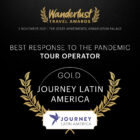It Takes Two to Tango

My first visit to Buenos Aires was a bit unconventional. Instead of arriving by plane, like most people, I caught my first sight of the great city from a boat.
Not a sailing-ship or an ocean-liner, on which millions of settlers - and immigrants as they were later called - had travelled to their promised lands, but a sleek hydrofoil from Uruguay. It was crammed full of porteños - as the people of Buenos Aires are known, because the city is Argentina’s major port - returning from a day out in the relative calm of Colonia del Sacramento, before stocking up on duty-free, like Brits on a binge in Calais.
As we spilled out of the hulk of white metal and smoked glass, and streamed through customs, I naïvely took out my passport in readiness and a beady-eyed officer caught sight of it and solemnly ordered me to stop. He leafed through the pages, trying to find the vital page with my photograph, his eyebrows stuck into his temples in a theatrical gesture of gravity. "Ah, British?", he asked rhetorically. I nodded apprehensively, pointing to the coat-of-arms and its Norman French mottoes. "England", he declared, meaning no disrespect for the Scots, Welsh or Manx - and here I expected my first lesson in South Atlantic diplomacy - "is a fantastic country. And London: what a city! Spectacular! Incredible!" "So you’ve been then?" "Never", he confessed. But he’d heard the Beatles, seen Lady Di’s picture, and "You have the world’s best football team. After Argentina’s, that is". This dialogue, which soon covered every aspect of British life from Thatcher to Sherlock Holmes, was all very well but, by the time he waved me through wishing me luck, I’d missed the free shuttle-bus downtown and had to take one of the black and yellow taxis lurking in the gloom outside like an exotic beetle.
That night I was thrown in the deep end of the Buenos Aires experience. A tango evening. I found myself in an atmospheric dive, full of tourists like myself, seated at tables laid with linen so crisp the cloths would have remained in place even if you’d taken the tables away from beneath them. Everyone had a look of excited expectation on their faces. After all, we’d come to see the best tango dancers in the very city that invented the most finger-tinglingly sensual of all dances. Two Japanese couples next to us quietly told each other anecdotes, and the women giggled into their cupped hands. A huge table of Scandinavians sat silently opposite, like extras in a Bergman film. A snappily-dressed compère mingled amongst us, speaking an Italianate Spanish - turning the tables on Placido Domingo singing Verdi - telling topical jokes nobody understood except my host, a couple of honeymooners from Patagonia, and one of the waiters; a particularly baffling gag involved a federal judge and three rent-boys.
Dinner was a vegetarian’s nightmare: the first course consisted of thin slices of beef coated in a mixture of tuna and mayonnaise; the second was a slab of beef of the same size and shape as the iceberg that sank the Titanic, with a side-salad consisting of two sprigs of parsley. It was the most delicious red meat I’d ever tasted - until dessert, that is, which was a fillet steak. The lights dimmed, and several men and women then began to dance. An unbelievable number of fish-netted legs wrapped themselves around a similar number of pinstriped thighs, even though there were only two dancers, while five miserable-looking old guys squeezed musical sighs and groans out of their bandoneons. I think that at one point a member of the Bergmanian party emitted a grunt that was Swedish for "Wow!" and ordered eight more bottles of Norton Malbec in the same breath.
The next morning I was flying into Mendoza, the capital of Argentina’s far west and, more importantly, the centre of its up-and-coming wine industry. It’s a modern, sophisticated city of beautiful people in skimpy cocktail dresses and sharp suits. Everyone in Argentina tells you how clean it is and how they sluice the pavements with aviation fuel to wash them - I couldn’t help looking to see if anyone dropped a cigarette-end onto the ground, but there are no cigarette-ends in Mendoza; I think people swallow them.
Only 100 kilometres to the west is the perma-snow of the Andean peaks, the emperor of them all being Aconcagua. At little short of 7000 metres, it’s one of the highest mountains in the world, and was sacred to the Incas and the Amerindian peoples who lived here before them. Now it’s sacred to mountaineers. On my first excursion from the city, up into the Alta Montaña, along a valley of multicoloured rocks, we passed a cemetery specially built for people who misjudged a foothold or slipped on an unswept ledge at 5000m, and I decided not to try and climb to the top. Instead I enrolled for a wine tasting tour.
I’d heard of a boutique winery called Viña el Cerdo, about 20 kilometres southeast of Mendoza, at a place called Maipú. I was received like a long lost friend at the little nineteenth century bodega by the owner, Pedro, who showed me every square inch of his vineyards and storage cellars, stacked with perfumed oak casks in cool brick vaults below ground-level. The winery produces only a few thousand bottles a year, but the quality is fabulous. I studiously imitated him as he swirled his tart chardonnay and then a smooth cabernet sauvignon, the colour of ripe aubergines, around crystal glasses. We got on so well, I ended up being invited to a barbecue that evening, attended by Pedro’s charming wife María Esther, his trusty employee Eduardo, and the children - all budding wine buffs. As we watched the sun slip behind the Andes, and the embers glowed beneath a cherry-red steak, and we sipped the previous year’s vintage Syrah, I suddenly remembered the Swedish for "WOW".
Andrew Benson, author of the Rough Guide to Argentina







































